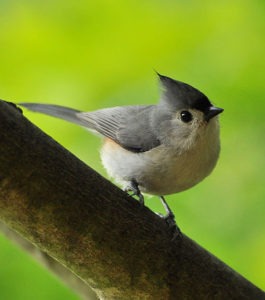The tufted titmouse (Baeolophus bicolor) is the only species of titmouse found in the eastern U.S. These curious, vocal songbirds are in the same family as the chickadees. In fact, once upon a time, they were in the same genus as chickadees, but genetic testing resulted in the genus being divided into two.

A tufted titmouse will have a light gray back, white belly, big black eyes, a black bill, and buffy colored feathers on its sides. Males and females look identical. They are smaller than cardinals, but like cardinals, titmice have a crest that they can raise and lower. Their crest is what gives this species its common name. Since there aren’t any other species of titmice in this region, the “tufted” part of their common name is often dropped in conversations between people from the eastern U.S.
Like the chickadee, titmice are frequent visitors to bird feeders, especially in the winter. Titmice love black oil sunflower seeds and will often grab a seed, fly a short distance, and save it for later by sticking it behind a piece of bark or in a small crevice. Not just any old seed will do, either. According to one study, titmice pick the largest seed they can find before they fly off to hide their bounty. During the warmer months of the year, titmice primarily eat insects, especially caterpillars. They are acrobatic enough to hang upside down from a twig to pick insects and spiders off the bottom of leaves.
Titmice live in wooded areas and nest in abandoned woodpecker cavities. (They’ll also sometimes nest in birdhouses.) Titmice build cup-shaped nests inside the cavity and they line their nest with fur or hair. Nesting season for titmice tends to run from March until May. It takes approximately a week and a half to two weeks for the eggs to hatch, and then another two to two and a half weeks for the young to leave the nest.
The female does all the incubating, while the male brings her food. During the first few days after the eggs hatch, the male will feed everyone in the family. After the nestlings get a little older, the female begins bringing food back to the nest as well. Often an unmated titmouse from the previous year will help bring food to the nest.
Titmice are very vocal birds and have a variety of songs and calls. Their most well-known call is a loud, clear whistle that is often described as sounding like it is saying “peter-peter-peter.” Both males and females sing, although males will sing more. Studies have shown that titmice are much more likely to respond to the song of a neighbor, than to the song of a stranger.
In addition to their many song types, titmice also have a number of calls. They use these calls to tell other titmice in the area about potentially dangerous situations. For example, the calls when a small predator, such as a screech owl, is in the area are different from the calls when something that isn’t as much of a threat, like a hawk, is in the area. When a titmouse hears a distress call, it will often approach and begin calling as well. They will also respond to the calls of chickadees and some of the other birds that are known for mobbing predators.
You can find tufted titmice in Kentucky woods and backyards year-round. They are a non-migratory species. Because they are here all year long, it is easy to begin to identify them, learn their songs, and get to know their behaviors. They may not be our most brightly colored bird, but they are definitely fun to watch.

This article was part of Shannon’s original Kentucky Pollinators and Backyard Wildlife blog which evolved into the blog for Backyard Ecology.

Backyard Ecology: Exploring Nature in Your Backyard
Nature isn’t just “out there.” It’s all around us, including right outside our doors. Hi, my name is Shannon Trimboli, and I am the host of Backyard Ecology. I live in southcentral Kentucky and am a wildlife biologist, educator, author, beekeeper, and owner of a nursery specializing in plants for pollinators and wildlife conservation. I invite you to join me as we ignite our curiosity and natural wonder, explore our yards and communities, and improve our local pollinator and wildlife habitat. Learn more or subscribe to my email list at www.backyardecology.net.

Leave a Reply